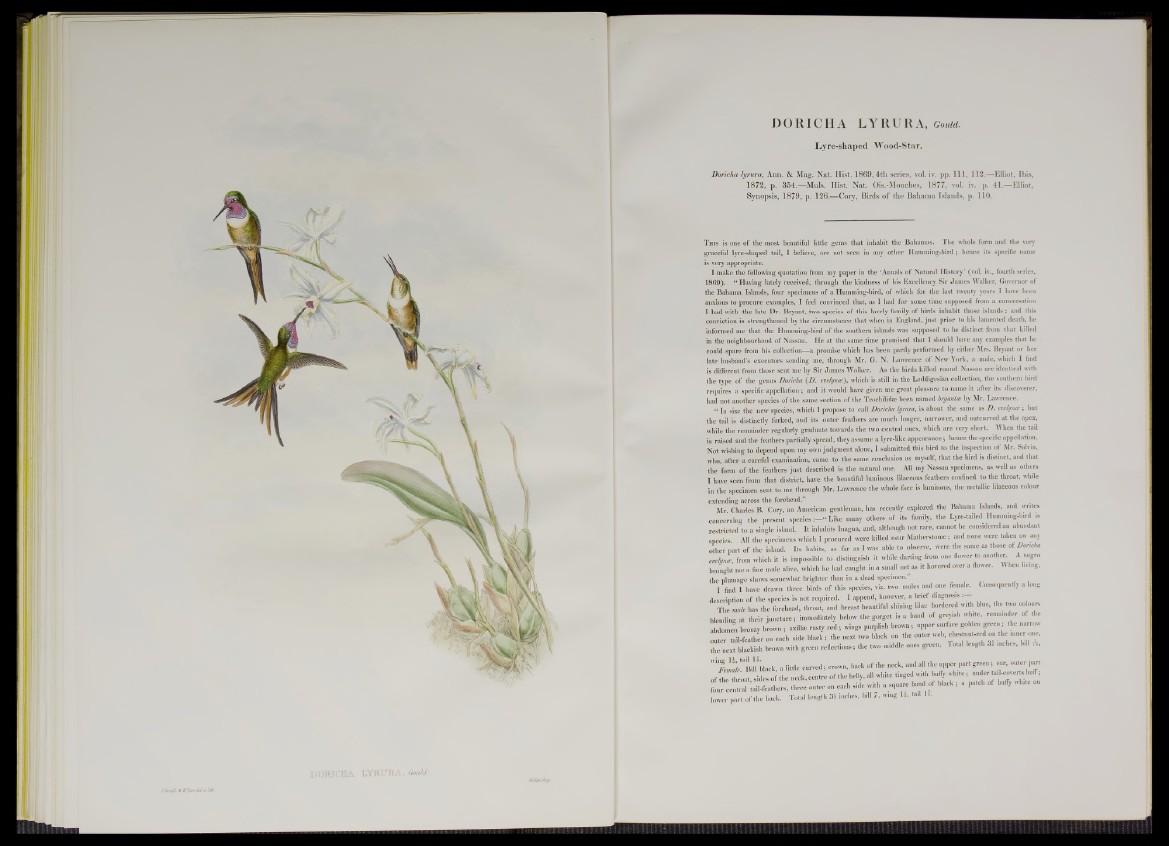
D O R IC H A L Y R U R A , GouLdj.
tj. GaaH &
DORICHA LYRURA, Gould.
Lyre-shaped Wood-Star.
Doricha lyrura, Ann. & Mag. N a t. H ist. 1 8 6 9 ,4 th series, vol. iv. pp. I l l , 112.— Elliot, Ibis,
1 8 7 2 , p. 3 5 4 .— Minis. Hist. Nat. Ois.-Mouches, 1877, vol. iv. p. 4 1 .— Elliot,
Synopsis, 1 8 7 9 , p. 1 2 6 .— Cory, Birds o f the Bahama Islands, p. 110.
T his is one o f the most beautiful little gems that inhabit the Bahamas. The whole form and the very
graceful lyre-shaped tail, I believe, are not seen in any other Humming-bird; hence its specific name
is very appropriate.
I make the following quotation from my paper in the ‘Annals of Natural History’ (vol. iv., fourth series,
1869). “ Having lately received, through the kindness of his Excellency Sir James Walker, Governor of
the Bahama Islands, four specimens of a Humming-bird, of which for the last twenty years I have been
anxious to procure examples, I feel convinced that, as I had for some time supposed from a conversation
I had with the late Dr. Bryant, two species of this lovely family of birds inhabit those islands; and this
conviction is strengthened by the circumstance that when in England, just prior to his lamented death, he
informed me that the Humming-bird o f the southern islands was supposed to be distinct from that killed
in the neighbourhood of Nassau. He at the same time promised that I should have any examples that he -
could spare from his collection—a promise which has been partly performed by either Mrs. Bryant or her
late husband’s executors sending me, through Mr. G. N. Lawrence of New York, a male, which I find
is different from those sent me by Sir James Walker. As the birds killed round Nassau are identical with
the type o f the genus Doricha (2). cvely/us), which is still in the Loddigesian collection, the southern bird
requires a specific appellation ; and it would have given me great pleasure to name it after its discoverer,
had not another species of the same section of the Trochilidse been named bryantm by Mr. Lawrence.
“ In size the new species, which I propose to call Doricha lyrura, is about the same as D. eoelynte; but
the tail is distinctly forked, and its outer feathers are much longer, narrower, aud outcurved at the apex,
while the remainder regularly graduate towards the two central ones, which are very short. When the tail
is raised and the feathers partially spread, they assume a lyre-like appearance; hence the specific appellation.
Not wishing to depend upon my own judgment alone, I submitted this bird to the inspection of Mr. Salvin,
who, after a careful examination, came to the same conclusion as myself, that the bird is distinct, and that
the form of the feathers just described is the natural one. All my Nassau specimens, as well as others
I have seen from that district, have the beautiful luminous lilaceous feathers confined to the throat, while
in the specimen sent to me through Mr. Lawrence the whole face is luminous, the metallic lilaceous colour
extending across the forehead.”
Mr Charles B. Cory, an American gentleman, has recently explored the Bahama Islands, and writes
concerning the present species W Like many others of its family, the Lyre-tailed Hnmming-hird is
restricted to a single island. It inhabits Inagna, and, although not rare, cannot he considered an abundant
species All the specimens which I procured were killed near Matherstome; and none were taken on any
other part o f the island. Its habits, as far as I was able to observe, were the same as those of Doncka
erelm*, from which it is impossible to distinguish it while darting from one flower to another A negro
- . . . .— —|— - net as it hovered over a <flIoawh;ebrp. When living,
brought me a fine male alive, which he had caught in a sma
the plumage shows somewhat brighter than in a dead specimen,
I find I have drawn three birds of this species, viz. two ma
ales and one female. Consequently a long
description o f the species is not required. I append, however, a brief diagnosis J
1 has the forehead, throat, and breast beautiful shining lilac bordered with blue, the two colours
blending at their juncture; immediately below the gorget is a band of greyish white,
remainder of the
abdomen bronzy brown ; axillffi rusty red ; wings purplish brown; upper surface golden green; th
le narrow
outer tail-feather on each side black, the next two black on the outer web, chestnut-red on the inner one,
the next blackish brown with green reflections; the two middle ones green. I otal length 31 inches, bill A,
Ihree outer on each side with a square hand o f black , a patch of bufly white on
lower part of the back. Total 1 th 31 inches, bill 7, wing 11, tail l i .